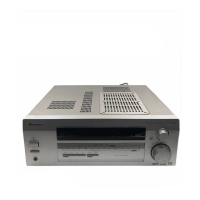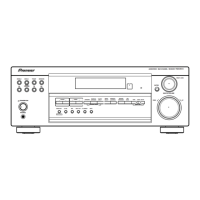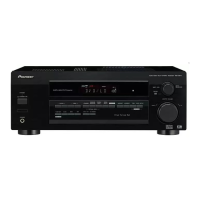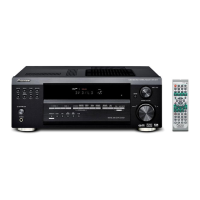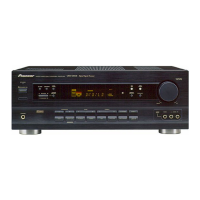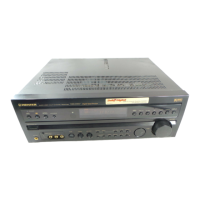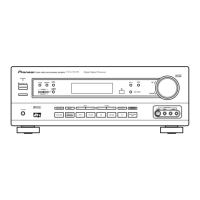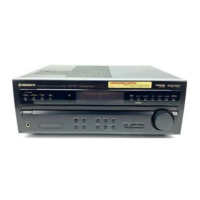Do you have a question about the Pioneer VSX-D511 and is the answer not in the manual?
Covers hazards like water, fire, and electric shock.
Explains lightning flash and exclamation point symbols.
Notes FCC regulations and potential interference.
States alterations may void user rights to operate.
Safety precautions related to power buttons and standby mode.
Explains the function and usage of voltage selector switches.
Lists all included accessories in the box.
Notes on placement and heat dispersal for safe installation.
Instructions to avoid cable bending and potential humming noise.
Warnings about battery installation, polarity, and disposal.
Factors affecting remote operation, like obstacles and light.
Explains surround sound and its immersive effect.
Mentions DVD-Video as a common source for home theater.
Notes automatic decoding of Dolby Digital/DTS signals.
Instructions for connecting DVD player digitally for surround sound.
Instructions for connecting the TV to the receiver.
General advice on connecting speakers, including impedance and polarity.
Explains how to connect speaker wires to terminals correctly.
Steps for powering on receiver, DVD player, subwoofer, and TV.
Ensuring the correct input source (DVD/LD) is selected.
Instructions for playing a DVD and adjusting the volume.
Explains the purpose and ease of use of the Quick Setup feature.
Steps to power on the receiver and initiate Quick Setup.
Instructions on selecting the correct speaker setup.
Instructions on selecting room size based on speaker distance.
Instruction to press ENTER to confirm the chosen settings.
Instructions for using audio/video cables for connection.
Instructions for using S-video cables for clearer picture.
Instructions for connecting digital audio and optical cables.
Explains the need for digital connections and types (coaxial/optical).
Instructions for connecting analog audio devices like cassette decks.
Instructions for connecting multi-channel analog outputs from DVD players.
Instructions for connecting video signal inputs from sources like DVD players.
Instructions for connecting AM loop and FM wire antennas.
Explains how to use antenna snap connectors.
Connecting an external FM antenna for better reception.
Connecting an external AM wire for better reception.
General advice on connecting speakers, including number, size, and polarity.
Step-by-step instructions for connecting speaker wires to terminals.
Tips on placing front, center, and surround speakers for optimal sound.
Advice on placing surround speakers relative to ear level and listening position.
Instructions on safe handling, routing, and replacement of power cords.
How to connect and use other Pioneer components via remote control.
Describes numbered buttons and indicators on the front panel.
Function of power buttons.
Meaning of the standby light.
Function for tuner presets and frequency tuning.
Location for receiving remote signals and function of ENTER.
Describes its multi-purpose use for selecting options.
How to connect headphones to the unit.
For memorizing and naming radio stations.
For switching station preset banks.
For switching between AM and FM radio bands.
For switching to mono reception.
For attenuating analog input signals to prevent distortion.
For adjusting display brightness.
Explains different listening modes like STANDARD and ADVANCED SURROUND.
Describes the various indicators shown on the receiver's display.
Explains what each SIGNAL SELECT indicator means (AUTO, DIGITAL, ANALOG, DTS, etc.).
Lights for advanced surround and loudness modes.
Explains tuner status indicators (STEREO, MONO, TUNED).
Shows the overall volume level.
Switches the receiver between on and standby modes.
Switches to Midnight or Loudness listening modes.
Selects listening modes like STANDARD and ADVANCED SURROUND.
Switches direct playback on or off.
Attenuates analog input signal level to prevent distortion.
Adjusts the fluorescent display (FL) brightness.
Accesses different menus associated with your DVD player.
Used for memorizing and naming stations.
Switches remote control functions to DVD mode.
Used to select the input source.
Adjusts the overall listening volume.
Controls for finding radio frequencies and selecting presets.
Switches between station preset banks.
Switches between auto stereo and mono reception of FM broadcasts.
Switches display between station name and frequency.
Displays the DVD's top menu.
Used for setup and DVD menu control.
Switches remote control to receiver mode.
Selects a channel when setting up surround sound.
Used to sound test tones for surround setup.
Sets the levels of the surround sound channels.
Adjusts the amount of effect in sound modes.
Explains the function of various DVD control buttons.
Overview of basic sound modes: Stereo/Direct, Standard, Advanced Surround.
How Stereo/Direct mode works, including downmixing.
How Standard mode decodes Dolby Digital, DTS, or Dolby Surround sources.
How to identify Dolby Digital software.
Description of the Pro Logic mode for 4.1 surround sound.
Description of Pro Logic II Movie mode for 5.1 surround.
Description of Pro Logic II Music mode for 5.1 surround sound.
Explains use with multi-channel sources like DVDs and LDs.
Simulates a movie theater environment.
Simulates a concert hall acoustic environment.
Simulates 6.1 surround channel listening.
Adds depth and space to stereo sources.
Using stereo sources with all speakers for multi-channel sound.
How to select input signals using the SIGNAL SELECT button.
How to switch between Stereo and Direct modes for playback.
Steps to select source, press STANDARD, and start playback.
How to select Pro Logic II modes for 2-channel sources.
How to cycle through Movie, Music, Virtual SB, and Expanded modes.
How to use Loudness and Midnight listening modes.
How to cycle through Midnight/Loudness modes using the button.
How to adjust bass and treble using the front panel controls.
Steps to select and play other audio sources.
How to select analog inputs for 5.1 channel playback.
General introduction to setting up the receiver for optimal surround sound.
Setting the distance for the center speaker from the listening position.
Setting the distance for surround speakers from the listening position.
Compressing the dynamic range of the sound track.
Isolating one channel when listening to discs with dual mono encoding.
Assigning a component to the coaxial digital input jack.
Assigning a component to the optical digital input jack.
How to configure speaker settings (number and size).
Choosing whether to use the subwoofer and its settings.
Setting the frequency division point for speakers and subwoofer.
Adjusting ultra-low bass tones to prevent distortion.
Setting distance from front speakers to the listening position.
Setting the distance for the center speaker from the listening position.
Setting the distance for surround speakers from the listening position.
Compressing the dynamic range of the sound track.
Isolating one channel when listening to discs with dual mono encoding.
Assigning a component to the coaxial digital input jack.
Assigning a component to the optical digital input jack.
Adjusting the volume levels for each channel for best surround sound.
Steps to tune to FM and AM radio broadcasts.
How to search for stations automatically.
Changing the frequency one step at a time.
Fast tuning by pressing and holding TUNING buttons.
Using MPX for better reception with weak FM signals.
How to memorize and store radio station frequencies for easy recall.
Step to tune to a desired station before memorizing.
How to assign names to presets for easier identification.
How to select and listen to memorized stations.
How to change the frequency step for successful tuning.
General steps for recording audio or video from various sources.
How to listen to the recording while it is being made.
Common problems and their solutions for the receiver.
Continues the problem/solution list for various issues.
Continues the problem/solution list for various issues.
Technical details of the amplifier section.
Technical details of the AM tuner section.
Other specifications like power, dimensions, and weight.
Lists the parts supplied with the unit.
Instructions on how to clean the unit's exterior.
Technical details of the amplifier section.
Technical details of the AM tuner section.
Technical details of the VIDEO section.
Technical details of the FM tuner section.
Technical details of the amplifier section.
Technical details of the AM tuner section.
Other specifications like power requirements and consumption.
Lists the parts supplied with the unit.
Covers hazards like water, fire, and electric shock.
Explains lightning flash and exclamation point symbols.
Notes FCC regulations and potential interference.
States alterations may void user rights to operate.
Safety precautions related to power buttons and standby mode.
Explains the function and usage of voltage selector switches.
Lists all included accessories in the box.
Notes on placement and heat dispersal for safe installation.
Instructions to avoid cable bending and potential humming noise.
Warnings about battery installation, polarity, and disposal.
Factors affecting remote operation, like obstacles and light.
Explains surround sound and its immersive effect.
Mentions DVD-Video as a common source for home theater.
Notes automatic decoding of Dolby Digital/DTS signals.
Instructions for connecting DVD player digitally for surround sound.
Instructions for connecting the TV to the receiver.
General advice on connecting speakers, including impedance and polarity.
Explains how to connect speaker wires to terminals correctly.
Steps for powering on receiver, DVD player, subwoofer, and TV.
Ensuring the correct input source (DVD/LD) is selected.
Instructions for playing a DVD and adjusting the volume.
Explains the purpose and ease of use of the Quick Setup feature.
Steps to power on the receiver and initiate Quick Setup.
Instructions on selecting the correct speaker setup.
Instructions on selecting room size based on speaker distance.
Instruction to press ENTER to confirm the chosen settings.
Instructions for using audio/video cables for connection.
Instructions for using S-video cables for clearer picture.
Instructions for connecting digital audio and optical cables.
Explains the need for digital connections and types (coaxial/optical).
Instructions for connecting analog audio devices like cassette decks.
Instructions for connecting multi-channel analog outputs from DVD players.
Instructions for connecting video signal inputs from sources like DVD players.
Instructions for connecting AM loop and FM wire antennas.
Explains how to use antenna snap connectors.
Connecting an external FM antenna for better reception.
Connecting an external AM wire for better reception.
General advice on connecting speakers, including number, size, and polarity.
Step-by-step instructions for connecting speaker wires to terminals.
Tips on placing front, center, and surround speakers for optimal sound.
Advice on placing surround speakers relative to ear level and listening position.
Instructions on safe handling, routing, and replacement of power cords.
How to connect and use other Pioneer components via remote control.
Describes numbered buttons and indicators on the front panel.
Function of power buttons.
Meaning of the standby light.
Function for tuner presets and frequency tuning.
Location for receiving remote signals and function of ENTER.
Describes its multi-purpose use for selecting options.
How to connect headphones to the unit.
For memorizing and naming radio stations.
For switching station preset banks.
For switching between AM and FM radio bands.
For switching to mono reception.
For attenuating analog input signals to prevent distortion.
For adjusting display brightness.
Explains different listening modes like STANDARD and ADVANCED SURROUND.
Describes the various indicators shown on the receiver's display.
Explains what each SIGNAL SELECT indicator means (AUTO, DIGITAL, ANALOG, DTS, etc.).
Lights for advanced surround and loudness modes.
Explains tuner status indicators (STEREO, MONO, TUNED).
Shows the overall volume level.
Switches the receiver between on and standby modes.
Switches to Midnight or Loudness listening modes.
Selects listening modes like STANDARD and ADVANCED SURROUND.
Switches direct playback on or off.
Attenuates analog input signal level to prevent distortion.
Adjusts the fluorescent display (FL) brightness.
Accesses different menus associated with your DVD player.
Used for memorizing and naming stations.
Switches remote control functions to DVD mode.
Used to select the input source.
Adjusts the overall listening volume.
Controls for finding radio frequencies and selecting presets.
Switches between station preset banks.
Switches between auto stereo and mono reception of FM broadcasts.
Switches display between station name and frequency.
Displays the DVD's top menu.
Used for setup and DVD menu control.
Switches remote control to receiver mode.
Selects a channel when setting up surround sound.
Used to sound test tones for surround setup.
Sets the levels of the surround sound channels.
Adjusts the amount of effect in sound modes.
Explains the function of various DVD control buttons.
Overview of basic sound modes: Stereo/Direct, Standard, Advanced Surround.
How Stereo/Direct mode works, including downmixing.
How Standard mode decodes Dolby Digital, DTS, or Dolby Surround sources.
How to identify Dolby Digital software.
Description of the Pro Logic mode for 4.1 surround sound.
Description of Pro Logic II Movie mode for 5.1 surround.
Description of Pro Logic II Music mode for 5.1 surround sound.
Explains use with multi-channel sources like DVDs and LDs.
Simulates a movie theater environment.
Simulates a concert hall acoustic environment.
Simulates 6.1 surround channel listening.
Adds depth and space to stereo sources.
Using stereo sources with all speakers for multi-channel sound.
How to select input signals using the SIGNAL SELECT button.
How to switch between Stereo and Direct modes for playback.
Steps to select source, press STANDARD, and start playback.
How to select Pro Logic II modes for 2-channel sources.
How to cycle through Movie, Music, Virtual SB, and Expanded modes.
How to use Loudness and Midnight listening modes.
How to cycle through Midnight/Loudness modes using the button.
How to adjust bass and treble using the front panel controls.
Steps to select and play other audio sources.
How to select analog inputs for 5.1 channel playback.
General introduction to setting up the receiver for optimal surround sound.
Setting the distance for the center speaker from the listening position.
Setting the distance for surround speakers from the listening position.
Compressing the dynamic range of the sound track.
Isolating one channel when listening to discs with dual mono encoding.
Assigning a component to the coaxial digital input jack.
Assigning a component to the optical digital input jack.
How to configure speaker settings (number and size).
Choosing whether to use the subwoofer and its settings.
Setting the frequency division point for speakers and subwoofer.
Adjusting ultra-low bass tones to prevent distortion.
Setting distance from front speakers to the listening position.
Setting the distance for the center speaker from the listening position.
Setting the distance for surround speakers from the listening position.
Compressing the dynamic range of the sound track.
Isolating one channel when listening to discs with dual mono encoding.
Assigning a component to the coaxial digital input jack.
Assigning a component to the optical digital input jack.
Adjusting the volume levels for each channel for best surround sound.
Steps to tune to FM and AM radio broadcasts.
How to search for stations automatically.
Changing the frequency one step at a time.
Fast tuning by pressing and holding TUNING buttons.
Using MPX for better reception with weak FM signals.
How to memorize and store radio station frequencies for easy recall.
Step to tune to a desired station before memorizing.
How to assign names to presets for easier identification.
How to select and listen to memorized stations.
How to change the frequency step for successful tuning.
General steps for recording audio or video from various sources.
How to listen to the recording while it is being made.
Common problems and their solutions for the receiver.
Continues the problem/solution list for various issues.
Continues the problem/solution list for various issues.
Technical details of the amplifier section.
Technical details of the AM tuner section.
Other specifications like power, dimensions, and weight.
Lists the parts supplied with the unit.
Instructions on how to clean the unit's exterior.
Technical details of the amplifier section.
Technical details of the AM tuner section.
Technical details of the VIDEO section.
Technical details of the FM tuner section.
Technical details of the amplifier section.
Technical details of the AM tuner section.
Other specifications like power requirements and consumption.
Lists the parts supplied with the unit.
| Type | AV Receiver |
|---|---|
| Channels | 5.1 |
| Dolby Digital | Yes |
| DTS | Yes |
| Video Inputs | 3 Composite |
| Video Outputs | 1 Composite |
| Tuning Range | FM/AM |
| Input Sensitivity/Impedance | 200mV/47kΩ |
| Speaker Impedance | 6Ω |
| Inputs | 3 Video |
| Digital Inputs | 1 Optical, 1 Coaxial |
| Dimensions | 420 x 158 x mm |
| Audio Inputs | CD, Tape, TV/SAT, DVD/LD, Video |

